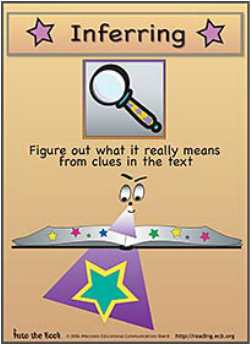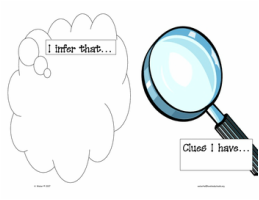What is Inferring?
Making inferences is a great strategy for reading comprehension. There are different levels of reading comprehension; literal comprehension, and higher-level comprehension. Inferring falls under higher-level thinking. According to Reading Problems (2014), inferences is implied information we draw from the text. Good readers draw many inferences from the text as they read. This can be a difficult skill for some readers, however, inferring can be taught with explicit instruction and strategies to help students understand this skill. According to Into the Book (2015), students may better understand inferring as using clues in the text to figure out what it really means. A more complex definition would be that readers think about and search the text, and sometimes activate their prior knowledge to construct meaning beyond what is literally stated. For example, there may be a short poem about a roller coaster. The text never states that the poem is about a roller coaster, but the students use clues in the text to help them infer that it is about a roller coaster. The text may say, "it goes up and down, and around and around, and makes my tummy tickle." Although, the text never stated it was about a roller coaster, reader can infer that it is about a roller coaster by using clues in the story. According to Marzano (2010), one simplified model for teaching inferences includes the following assumptions:
- We need to find clues to get some answers.
- we need to add those clues to what we already know or have read.
- There can be more than one correct answer.
- We need to be able to support inferences.
Visual Representations
Content Areas
History- This strategy could be adapted in a history lesson by having the students look at an image from back in the day. They can look at the image and make inferences about that time period or person by using hidden clues in the image. For example, they may look at a picture from back in the day of people farming. They may make an inference that life was harder back then, and people had to work hard to put food on the table.
Reading- This strategy is a reading comprehension strategy and can be incorporated in all reading lessons. If a student is unsure of something they read about in their text, they may use clues in the text to make a guess on what the text may be talking about. For example, if the text is describing a roller coaster, but never actually mentions roller coasters, then the students may make an inference that the story is about roller coasters. However, the story may change, which may change the students inference.
Math- Inferring can be adapted in a math lesson by having the students predict how to solve a problem. The teacher may use the top-down theory. They may start by giving the students a problem and having them infer or predict how to solve it by using their prior knowledge and text clues. Then, the teacher will explain how to solve the problem once the students have a chance to solve it on their own.
Science- This strategy could also be adapted in a science lesson by having the students make inferences based on observations. Some people may think that observation and inferences are identical, but they are not. For example, a student might make an observation that the grass is wet. The student will then infer that it rained or the sprinkler went off. It is important that teachers express to the students that they are similar but not identical.
Reading- This strategy is a reading comprehension strategy and can be incorporated in all reading lessons. If a student is unsure of something they read about in their text, they may use clues in the text to make a guess on what the text may be talking about. For example, if the text is describing a roller coaster, but never actually mentions roller coasters, then the students may make an inference that the story is about roller coasters. However, the story may change, which may change the students inference.
Math- Inferring can be adapted in a math lesson by having the students predict how to solve a problem. The teacher may use the top-down theory. They may start by giving the students a problem and having them infer or predict how to solve it by using their prior knowledge and text clues. Then, the teacher will explain how to solve the problem once the students have a chance to solve it on their own.
Science- This strategy could also be adapted in a science lesson by having the students make inferences based on observations. Some people may think that observation and inferences are identical, but they are not. For example, a student might make an observation that the grass is wet. The student will then infer that it rained or the sprinkler went off. It is important that teachers express to the students that they are similar but not identical.


